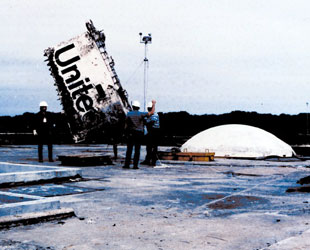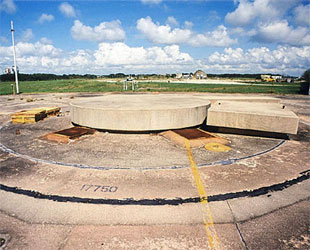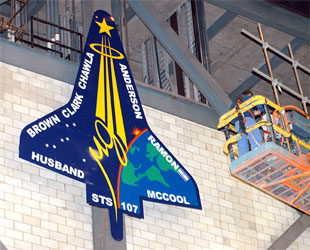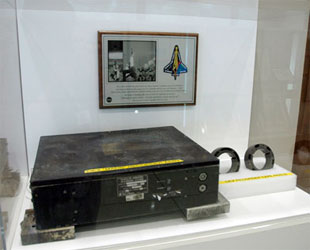January 31, 2011 — The National Air and Space Museum may incorporate debris from space shuttles Columbia and Challenger in its new gallery dedicated to the soon-ending shuttle program. The display will only go forward however, if the families of the shuttles' fallen astronauts and NASA officials agree with the museum's plans.
The solemn artifacts, which were recovered in the wake of the loss of shuttle Challenger 25 years ago last Friday and the loss of Columbia eight years ago on Tuesday, would be used to teach the public about the conditions that led to the two tragedies, according to curator Valerie Neal who spoke exclusively with collectSPACE.
"We now have an exhibit environment, the new 'Moving Beyond Earth' exhibit, where we will address each of the tragedies. So, having an artifact related to them would be appropriate. It would be part of a story and it wouldn't be just an object that people would stare at and say 'Wow, that's part of the tragedy.' But it would it be an object that they could learn something from," said Neal.
Challenger and its seven-person STS-51L crew were lost 73 seconds into the orbiter's 10th flight on Jan. 28, 1986. Cold weather had compromised an O-ring seal on one of the shuttle's two solid rocket boosters, resulting in hot gas burning through the right booster, damaging the hardware that connected it to the vehicle and causing the structural failure of the shuttle's external fuel tank. Challenger then broke apart, succumbing to aerodynamic forces, and fell in pieces into the ocean.
Columbia, with its seven STS-107 astronauts, broke apart during reentry into Earth's atmosphere on Feb. 1, 2003. Its loss was predicated by its left wing sustaining damage 16 days earlier during launch. A small piece of external tank insulating foam struck the wing's leading edge, leaving a hole that went undetected during the flight. On reentry, hot plasma entered the wing, tearing it apart, and the resulting loss of control led to Columbia's disintegration.
Stored in silos
Debris recovery efforts were staged immediately following both tragedies to obtain the evidence needed to learn what had ultimately claimed each vehicle.
In what the U.S. Coast Guard categorized at the time as its "largest surface search in which they had participated," about 120 tons of Challenger wreckage were raised off the floor of the Atlantic Ocean. The retrieval accounted for 30 percent of Challenger's total structure, including about 75 percent of its crew cabin and surrounding fuselage.

Challenger debris being loaded into a Complex 31 silo. (NASA) |
When the investigation concluded, NASA began looking at what to do with the debris.
"We did an evaluation on where would be the best place to store the debris," Ronald Phelps, NASA's project manager who oversaw the Challenger reconstruction effort, recalled in an interview with collectSPACE.com. "We looked at the Vehicle Assembly Building, building a new facility, and at some places on the Air Force side [of Cape Canaveral]."
Ultimately, they settled on two silos, each 78 feet deep by 12 feet in diameter, which supported Minuteman missiles up until 1970.
"We decided that Complex 31 and 32 would be the best place to store it. The complex had the silos themselves — which were missile silos — had a battery room and an equipment room for each complex. So we went into those, cleaned everything out, waterproofed everything, and got them ready to receive the debris," said Phelps.
Over a two month period, 102 crates were lowered into the underground chambers. Parts too large to be boxed were stacked inside the silos themselves.
"After it was all done, we built some fairly large concrete caps and capped the access off," said Phelps. "You can't get into them now without raising these large caps."

Large concrete caps were fabricated to seal the missile silos used to store Challenger debris. (CCAFS Virtual Tour) |
The silos however were not intended to be a burial site or memorial for Challenger, but rather a storage site.
"There are records where things are in the storage sites in case we ever had to get back into them for any reason. We recorded where we placed each piece," said Phelps.
According to Phelps, the silos themselves have not been reopened since, but the side chambers have been entered to deposit pieces of Challenger debris found since and to temporarily remove and later return components for study by NASA.
None of Challenger has been removed for display.
A library for research
By comparison, Columbia is far more accessible.
Unlike Challenger, which was victim to many of the same forces seen during aircraft accidents, Columbia was lost as it crossed the boundary between space and the Earth's atmosphere, a process not fully understood by engineers and scientists.

A 20-foot STS-107 emblem hangs in the Vehicle Assembly Building, marking where Columbia's debris is held. (NASA) |
As a result, NASA carefully catalogued the nearly 84,000 pieces of Columbia recovered, and after the investigation, stored them in a converted room located on the 16th floor of the same Vehicle Assembly Building that once readied Columbia for launch.
"We kind of think of it as more of a library. It's a place of learning," said Scott Thurston, who led NASA's Columbia Preservation Team, soon after the room was completed.
"We know exactly where each piece of Columbia is," said shuttle launch director Mike Leinbach. "We could probably retrieve any piece of Columbia we wanted to in a couple of hours."
Researchers can request and have been granted debris on loan for study.

Columbia's recovered data recorder on display for employees at NASA's Johnson Space Center in Texas. (collectSPACE) |
NASA has moved at least one piece of Columbia, a data recorder, to the Johnson Space Center in Houston, Texas where it is on display outside the employee auditorium.
In 2008, NASA also toured a small collection of recovered debris around NASA centers as part of an exhibit devoted to promoting safety. The display was accessible to NASA employees but not the public.
Choosing pieces for display
"I did see the Columbia debris and on that basis I've some ideas about what I might want to exhibit from Columbia," said Neal. "I really do not have a specific idea about the Challenger because I just never saw [its debris] in person. I suppose I could study the pictures of [when Challenger's debris was laid out] in the hangar and maybe get an idea that way."
According to Neal, who curates the space shuttle program for the National Air and Space Museum, whatever debris was chosen, it would need to tell a story.
"Whatever we'd be interested in showing would have to have a story to it in its own right and not just be displayed as a piece of debris from the vehicle as simply a sign of the tragedy. It would need to have more content to it, otherwise it would be too much like just displaying a car that is involved in a terrible smash up so that people can see how awful it was. We wouldn't want to just do that. There's something kind of prurient about that."
"So if there are articles that had a particular story to them, then I think those would be candidates for display," Neal said.
Those debris stories would be displayed inside the Moving Beyond Earth gallery, an exhibition devoted to the shuttle and space station programs, now under development. The first phase of the gallery opened to the public in 2009.
The debris would be placed aside other exhibits designed to explain the tragedies and lessons learned from them.
"From the manufacturers we are going to try to get a piece of an O-ring, if not an entire O-ring and also a piece that has burn-through, so you can see, graphically, what burn through or near-burn through looks like," shared Neal.
"And for the Columbia discussion, we're obtaining a mock up of the [external tank] PAL ramp area and a sample of the foam, so you can see what the foam looked like and how big a piece of foam was it. And we'll probably also have, if not a whole leading edge panel, some portion of a wing leading edge panel."
"That all fits together and gives [the debris] context. It gives a story so you can learn something, so it is not just a macabre object. People used to go to museums to look at shrunken heads or something like that. We don't want to just put a curiosity piece out there as that is kind of morbid, which people wouldn't learn anything from."
"We want to create enough of a story that [visitors] can achieve a better understanding [of the tragedies]. If the object helped to accomplish that, then I think it would be appropriate to display the object," explained Neal.
When the time and circumstance is right
Several factors needed to come together for Neal to begin considering requesting Challenger and Columbia debris.
"I don't know if my predecessor here ever pursued trying to get any of the Challenger debris on display here. I don't have any records to indicate that that was the case. But we actually didn't have much of a place for it at the time because we didn't really have a shuttle exhibit," said Neal.
"But since I have been here, I've always thought that once we had a place to integrate the tragedies into the broader story it might well be appropriate to have something on display from each of the tragedies," she explained.
But even establishing the Moving Beyond Earth gallery is not enough to drive the decision alone. She will also need to convince NASA, which in the past has been split on the subject.
"I think if we presented a solid enough plan, NASA would allow us to display something," stated Neal. "I know that within NASA, at least early on, there were kind of divided opinions about whether it was appropriate to display any of it and some people in the position to make the decision thought it was just too soon and too raw."
"Others [within NASA] were quite sure that at some point it should become visible because there was so much to be learned from it."
But even if the space agency were to approve the display, Neal also wants to gain the approval from one other group: the Challenger and Columbia fallen crews' families.
"I think we owe them respect. I don't know that any one of them would presume to have veto power but they tend to operate by consensus. So if the consensus of the group of crew family representatives told us it was alright, then I think the museum would feel it was alright, too."
Based on earlier conversations with some of the Columbia crew's families, Neal already has an understanding about some of their concerns.
"We have gained a sense from the Columbia families that they would not be comfortable with anything on display while their children were young," shared Neal. "But once their children were grown and mature enough to possibly encounter the artifact on their own when they were visiting the museum, they would more comfortable then."
"And of course the Challenger children are all more than grown by now. But there would be some time before that would true of the Columbia children."
"We also thought that it would probably need a minimum of about 10 years to pass for some of the rawness of the experience to heal over and of course that amount of time has more than passed for Challenger and also, now has [almost] passed for Columbia," Neal continued.
"I am about to notify [the crews' families] that we think the time and and circumstance is right if they are ready," Neal shared with collectSPACE. "I think it is our responsibility to lay out our plans for them to understand and not expect them to give blanket approval without telling them first what our plan is," explained Neal.
June Scobee Rodgers, the widow of Challenger's STS-51L commander, Dick Scobee, expressed interest in meeting with Neal after first learning about the potential display of debris from collectSPACE.
"I would like to know how they are handling [the debris] with reverence. In fact, I could come to Washington and I could look to see what they are planning to do," she said.
